Fountain-la-Mallet Churchill Mk VII Tank
North of the huge French port town of Le Harve near the town of Fountain-la-mallet there is a preserved WW2 British Churchill Mk VII tank standing at the side of the tree lined road. It forms the major part of a war memorial to all the soldiers who lost their lives during Operation Astonia, the Capture of German held Le Harve on the 10th September 1944.
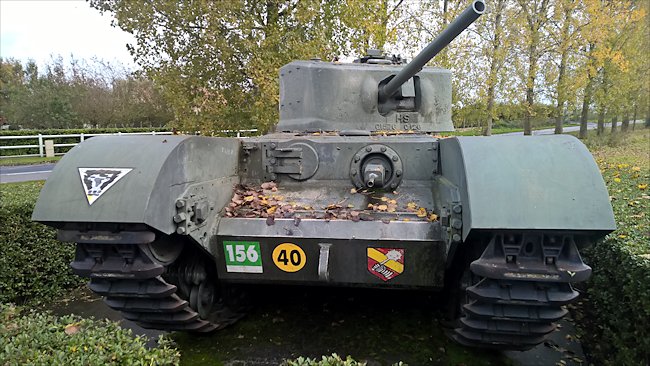
Churchill Mk VII Tank at the 'Battle of Le Harve' Memorial in Fontaine-la-Mallet, France.
Location
Set your Sat-Nav for the town of Fontaine-la-Mallet on the hills above the port of Le Harve. The Churchill Mk VII tank Memorial is on the D52 Route de Fontaine-la-Mallet road at the junction with the Rue Roger Stil.
Specification
The British Army called the Churchill Tank used in the Battle of Le Harve Memorial Tank, Infantry, Mk VII (A22F). It was armed with the British 75mm gun. It was wider than previous versions and had more protective armour plating. Because of the extra weight it was sometimes called the 'Heavy Churchill'.
On the Mark VII, the hull front armour was made up of a lower angled piece of 140 mm, a nearly flat 57 mm plate and a vertical 152.2mm plate. The hull sides, were for the most part, 95 mm. The rear was 51 mm and the hull top only 13.3 mm. The turret of the Mark VII was 152.4 mm to the front and 95 mm for the other sides. The turret roof was 20 mm thick. The most significant factor in the improved armour protection on the Mk VII Churchill tank was the use of welding instead of rivets. The hull doors changed from square to round which reduced stresses.
The Churchill tank's Bedford horizontally opposed twin-six petrol engine was never upgraded so the additional armour's weight put extra load onto the power plant which meant that top speeds were reduced. The Mk I Churchill tank was already very slow with a top road speed of only 16 mph (26 km/h). The Mk VII heavy Churchill tank could only manage a top road speed of 12.7 mph (20.5 km/h). They were also prone to more mechanical break downs because of the extra demand put on the engine.
The tank was also armed with two 7.92mm Besa machine guns. One fitted next to the main gun in the turret and the other in the hull. It had a five man crew: commander, gunner, driver, loader/radio operator and co-driver/machine gunner.
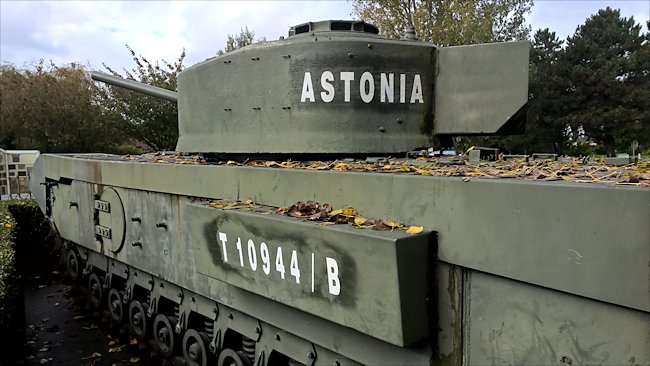
This Churchill Mk VII Tank is in the town of Fontaine-la-Mallet
The tank
The Churchill Mk VII tank was restored and donated by the Tank Museum Bovington, Dorset in England. The British Army helped transport the tank to the site of the memorial on 10th July 2000. It was positioned infront of a symbolic representation of an anti-tank ditch that had been breached by a replica of an assault bridge, The tank is now surrounded by a fully grown green box hedge. Churchill tanks were used in the attack on Le Harve.
Operation 'Astonia' 10th September 1940
The memorial plaque reads as follows, 'At the beginning of September 1944 Allied forces reached Belgium's boundaries. The Fortress of Le Havre called 'Festung' by the Germans was the most important port on the English Channel for supplying fuel, munitions and food. The Germans defended the 'Atlantic Wall' with batteries, guns, strongpoints, minefields and an anti-tank ditch from the cliffs (at the west part of Octeville-sur-Mer) to Montivilliers where the valley was flooded by the river 'La Lezarde'.'
'Operation Astonia began 10 September 1944 under OC General Crocker of 1st British Corps, involving two divisions. 49th West Riding Infantry (Polar Bears) on the east under General Barker: 51st Highland Division on the west under General Rennie, supported by several artillery, three armoured brigades and 1 specialised armoured brigade (the 'Hobbard' brigade that distinguished itself on D-Day). About 4500 soldiers took part. Opposite 11,000 Germans were entrenched.'
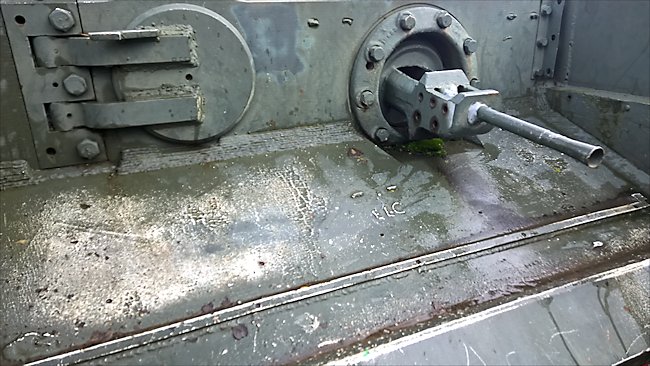
WW2 Churchill Mk VII tank hull mounted 7.92mm Besa Machine gun. Notice the driver's position is on the right unlike the German and American tanks.
A preliminary bombing 4.15pm – 5.45 pm dropped 4720 tons of bombs. At 5.45pm the assault began from the North, half a mile from here. Three lines were expected to cross minefields and the anti-tank ditch 'Laura Hazel May'. The Allies used flails and assault bridges. The first strongpoints were reached at 7.22 (with heavy losses). The second phase of Astonia began 11th September 1944 at midnight towards Fontaine-la-Mallet, at 05.30 heading from Gainneville to the city. The German garrison capitulated on 12th September 1944.'
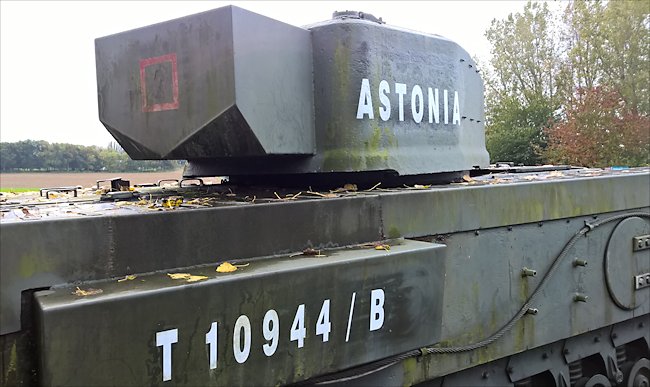
Notice the round shaped hatch on the side of this British Churchill Mk VII tank. Pervious versions had square hatches.
Churchill Tank Crew - Colour Sergeant P Findlay
During WW2 I was a tank crew member on Churchill Mk IV and VII tanks. In Normandy supplies were dished out to Churchill tank crews in 15 man pack boxes. These included food supplies like tins of rolled bacon, bully beef (it is a bit like corn beef), jam and vegetables. It also included chocolate, cigarettes, toilet rolls, board sweets, tins of condensed milk and biscuits. If we were lucky sometimes a mobile bakery unit caught up with us and we had fresh bread. Occasionally mobile shower units were in our vicinity.
Every day we had to do maintenance on the tank. You had to be very careful when opening and closing the engine hatches. Some men lost their fingers due to their weight. Petrol was issued in square cans. We would have to pierce the tin making two holes, one for the air to go in and the other for the fuel to pour out. You have to be very careful not to spill any the fuel onto the hot engine otherwise it would ignite. We all preferred to use the Jerry cans but they weren’t as readily available.
Inside the tank there was a small Primus stove which we used for making tea on the move amongst the 80 rounds of high explosive and armour piercing ammunition. Our Churchill tanks were rugged and reliable but during the first battle in Normandy the 3rd Tank Battalion Scots Guards, 6th Guards Tank Brigade lost 25 men killed. On day one of Operation Bluecoat 12 out of 16 of our Churchill tanks were destroyed around hill 226 south of Caumont. The 88mm guns fitted to four German Jagdpanthers did most of the damage. They were concealed within a wooded area on the Battalion's left flank. Their advance was delayed as the 43rd Division had problems progressing through the mine field. Churchill tanks from their sister squadron were able to disable three of the four German tank destroyers by damaging their tracks. The fourth got away.
When my Churchill tank was hit by a German 88 mm armour piercing shell there is an incredible noise followed by the smell of burnt paint and molten metal everywhere. Our co-driver, John Willie Harvey was one of those killed on that day. He is buried at Hottot les Bagues Commonwealth WW2 Military Cemetery. We dealt with losses quietly and got on with the job in hand. After Normandy we went on to liberate Belgium and Holland. Then we turned towards the Reichswald Forest and crossed the Rhine River near Xantern and fought our way across Germany.
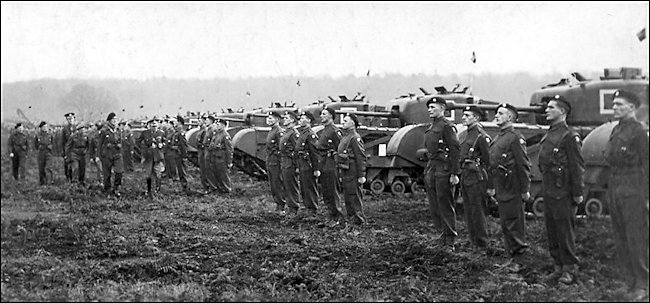
British Churchill Mk IV tanks of the 3rd Tank Battalion Scots Guards, 6th Guards Tank Brigade Thoresby Hall, Nottinghamshire, December 1943
D-Day 1944 books

